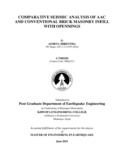Please use this identifier to cite or link to this item:
https://elibrary.khec.edu.np:8080/handle/123456789/497Full metadata record
| DC Field | Value | Language |
|---|---|---|
| dc.contributor.advisor | DR. MANJIP SHAKYA | - |
| dc.contributor.author | SHRESTHA, ASMITA | - |
| dc.date.accessioned | 2023-06-07T10:21:30Z | - |
| dc.date.available | 2023-06-07T10:21:30Z | - |
| dc.date.issued | 2021 | - |
| dc.identifier.uri | https://elibrary.khec.edu.np/handle/123456789/497 | - |
| dc.description.abstract | Brick masonry infill is one of the most common type of infill used in RC frame and steel frame structure throughout the world due to its low cost, durability, aesthetics, good acoustic and thermal properties. The infill walls can be built with various materials such as conventional bricks, solid concrete block, hollow concrete block, AAC blocks, earth bags etc. Autoclaved aerated concrete (AAC) blocks are light weight and have been widely used all over the world as a potential infill material from recent few decades. Presence of opening is usual in the wall as door and window in normal buildings. These openings of the infill cut across the diagonal strut model arise conflicts. Walls with opening are seem to be real and logical in actual field and it should be considered in structural modelling to obtain more reliable responses when subjected to seismic actions. Although there is huge variation in material properties of masonry infills, infills have high stiffness and strength and play a decisive role in seismic behavior of reinforced concrete (RC) frame buildings. Moreover, national codes of most of the countries do not mention about modeling of infills in structure systems. There are several analytical models for masonry infills are available in literature, among which one of the most common one is equivalent diagonal strut models. Therefore, a comparative study is carried out for analytical models for masonry infills using equivalent diagonal single strut for masonry infills. In this study, the basic objective was to study and compare the structural behavior and performance having brick infill and AAC blocks with opening and without opening and also to interpret and evaluate the results for AAC blocks infilled RC frame structure as the alternative building material. In accordance with this macro modelling (equivalent strut modelling) approach was used to study effect of infill walls with RC frame on lateral resisting capacity of the building. The research found that base shear is very less for AAC infill as compared to brick infill and also inter storey drift is significantly larger for AAC infill but within permissible limit. All total eighteen models are anlayzed and compare d with the basic design parameter like base shear force, displacement and as well as earthquake parameter like inter storey drift, story shear etc. | en_US |
| dc.language.iso | en | en_US |
| dc.subject | Infill panel, Equivalent strut modelling, stiffness reduction factor, drift ratio | en_US |
| dc.title | COMPARATIVE SEISMIC ANALYSIS OF AAC AND CONVENTIONAL BRICK MASONRY INFILL WITH OPENNINGS | en_US |
| dc.type | Thesis | en_US |
| local.college.name | Khwopa Engineering College | - |
| local.degree.name | ME Earthquake | - |
| local.degree.level | Masters | - |
| Appears in Collections: | Master of Science (M.Sc) in Earthquake engineering | |
Files in This Item:
| File | Description | Size | Format | |
|---|---|---|---|---|
| Asmita Shrestha_2018.pdf Restricted Access | 4.1 MB | Adobe PDF |  View/Open Request a copy |
Items in DSpace are protected by copyright, with all rights reserved, unless otherwise indicated.
